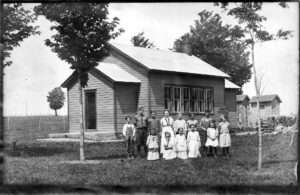By Carol Fisher-Linn
“The one-room schoolhouse was once a signature of the American education landscape with roughly 190,000 such schools in 1919. Today, roughly 400 remain.” This from a Forbes article (“Why the One-Room Schoolhouse is a Vision for the Future, Not just a Relic of the Past”) by Brandon Busteed, Nov 7, 2020. He argues that what may be considered a quaint relic from the past or the vestiges of rural America, “the one-room schoolhouse may instead be a vision for the future of education. The kind of teaching and learning that takes place in such an environment is much needed in today’s world and a modern-day version of the one-room schoolhouse can serve as a model for the renewal of education.”
His comments echo the words of Jerry Apps who narrated a PBS Wisconsin documentary on one-room schoolhouses from his own perspective, having attended one for eight years. Apps felt that he and his fellow “scholars” as they were called, benefitted in ways not available to today’s students in large schools mainly because today’s students don’t have advantage of “community.” There is an old Lakota tribe philosophy that holds the belief that a person is not merely an individual but an integral part of the universe. The one-room schoolhouse opened that universe. One teacher for many grades meant that the older kids who had already mastered the material helped the younger ones. There have been studies done which show that indeed, students do learn better when they teach the material to others, all the while preparing them for success, especially in workplaces where group-based work across teams of different ages and backgrounds is prevalent. In one-room schoolhouses, everyone pitched in. If it wasn’t helping with a lesson, it was fetching wood for the stove, or drinking water for dipping, sweeping, cleaning the blackboard and erasers. You know, the pandemic, in a way, gave everyone a sort of one-room schoolhouse effect, with parents and siblings involved with each other as they worked their way through Zoom classes or Facetime. Parents pitched in. Older siblings did likewise. We were, in a way living and learning in our individual one-room schoolhouses, weren’t we?

In Ellicottville, classes began in settler’s homes. There may have been a few schoolhouses but many of the classes were held all over town in the courthouse, in business establishments, in homes and finally a large school building was erected in 1887 at Ellicottville’s four corners, bringing all the students under one roof. In Cattaraugus County, there are more than 170 common (elementary mostly one-room school buildings) remaining. According to research done by Sue Cross, Town of Mansfield historian, “The combined number of schools, both rural one room and village multi-room schools in 1915 was 308.” Of course, if we travel out into our even more rural areas today, we will still find many white one-room schools with a bell tower, a playground, a softball field and two outhouses (girls-boys) as we travel through Amish country. These are active schools for the Amish children who attend school until the completion of 8th grade.
In the early 1800’s only boys attended; when girls arrived, there were often two doors (girls-boys) and they sat on opposite sides of the room. There may have been as many 20-30 children. Desks came in graduated sizes with a bench often at the front for “recitation.” The blackboard was either slate or painted wood, and sometimes a parent-approved paddle sat next to the teacher’s desk. Rules were firm and generally adhered to. Pictures of Presidents, a globe, sometimes a treasured bookshelf and the American flag sat in a corner at the front of the room to which the children pledged allegiance daily. Lunch pails (often reused covered lard cans) waited for the children’s 1-hour lunch/recess break at the back of the room. Most schoolhouses had many windows to catch the sun (otherwise oil lanterns were lit). In the center of the room sat the pot-bellied stove which the teacher lit long before the first students arrived at 9am to the sound of her bell. The teachers went to “normal” school for two years to be certified to teach. Most were 16-18 years old, not much older than their students. Here is a link which might interest readers: (https://news.illinoisstate.edu/2014/02/old-school-reflections-one-room-schoolhouse-teachers/)
In Cattaraugus County, by the 1950’s, there were no more one-room schoolhouses functioning mainly because of centralization and changes in transportation (although, earlier, there were available to students horse drawn school “buses”). Many of the schoolhouses were either demolished or have been converted to homes, museums, or storage buildings, as is the one in Willoughby, not far from Ellicottville, that many of you pass on your way to Olean. (Where in the world in Willoughby? – Watch this paper later this month to find out.) Oh, for the “good old days…”
